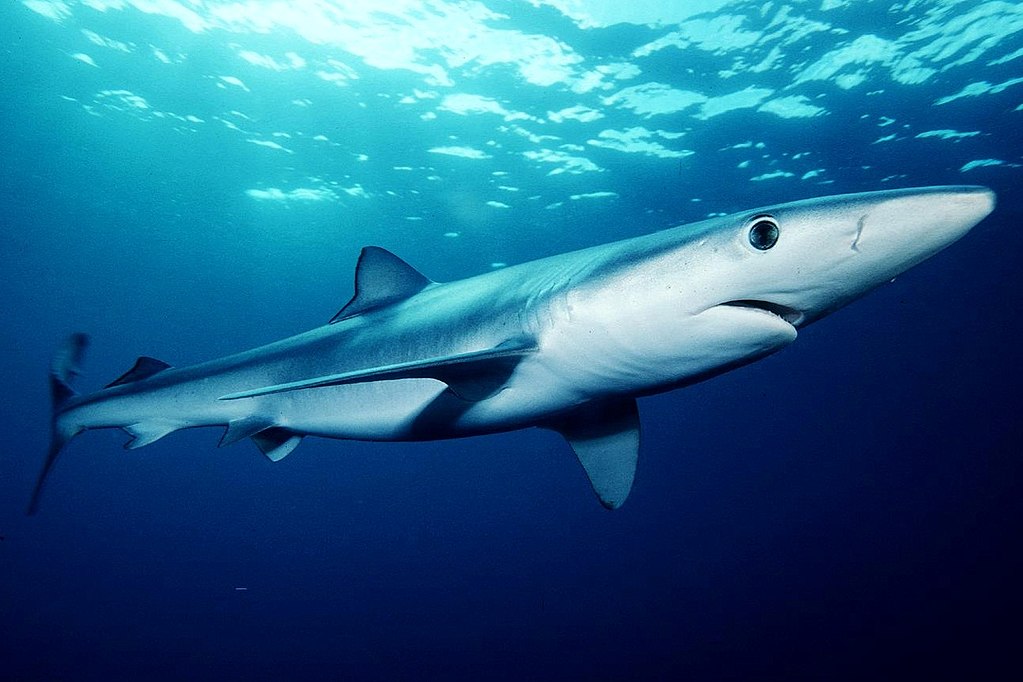The blue shark is one of those unappreciated masters of the ocean. We all know the great white shark, but what about the great blue shark? For real, another name for this bad boy is: great blue shark. How come nobody makes movies about a blue shark terrorizing a small beach town? Well, because a blue shark doesn’t care to come so close to shore when it has the whole ocean to prowl for squid and deep-sea fish. They just don’t get enough exposure to make it to Hollywood; but that’s what we’re here for. Here are the answers you didn’t know you craved for the most common questions about the mysterious blue shark.
Where Does The Blue Shark Live?
In the open oceans around the world from 50º N to 50º S in depths up to 1150 ft (350m) with preferred temperatures of 54-68º F (12-20º C).
In the Pacific ocean, they prefer the area from 20º N to 50º N, migrating further north during the summer and further south during the winter to stay in their ideal temperature range. The population stays relatively constant between 20º S and 20º N.
In the Atlantic, they follow the currents in a predictable clockwise pattern.
What Does a Blue Shark Look Like? Is a Blue Shark Really Blue?
Yes, the blue shark is indeed blue. The top side, what we would consider its back, is the darkest blue. On the sides it has a lighter blue color, and on the belly, like most sharks, it is white.
Blue sharks have a torpedo shape to them with a long snout and a long, slender body. They look a bit like large makos. They have uniquely long, narrow, and pointed side fins (pectoral fins).
The upper teeth are straight while the slightly larger lower teeth curve back.
They have very large eyes.
How Do Blue Sharks Reproduce?
They breed like most sharks: the male inserts his clasper into the female’s cloaca, releasing sperm to fertilize the female’s eggs.
Though blue shark mating has yet to be observed, we believe the male bites the female during the mating ritual. Noticeable bite scars on females support this theory, which also most likely explains why females have developed skin 3 times as thick as that of the males. The bite marks on sexually mature females are so common that they are used to visually distinguish male and female blue sharks.
Blue sharks are viviparous, like humans, meaning the mother carries and nourishes the unborn pups in a placenta until giving live birth to anywhere from 4 to 135 pups. This gestation period can last from 9 months up to a year.
Other shark species have been observed to be capable of asexual reproduction. This may be possible for blue sharks as well, but has yet to be documented.
What Does a Blue Shark Eat?
Blue sharks eat lots of small food, especially bony fish and squid. On top of this, like other sharks they eat whatever they can, including: smaller sharks, sea birds, and dead mammals.
Squid is probably the most important part of a blue shark’s diet. They are known to accompany schools of squid that congregate for mating or other purposes and lunge into the crowd for a bite.
Though typically slow swimmers, blue sharks are capable of bursts of speed. This comes in handy when pursuing more dispersed and evasive prey. An aware squid, for example, can try to outmaneuver the shark, but the blue shark has the speed and agility necessary to twist and capture even a lone, prepared and alert squid in the corner of its mouth.
Are Blue Sharks Dangerous?
Yes. Blue sharks are dangerous and a blue shark can kill you. Attacks, however, are quite rare. The International Shark Attack File records 13 unprovoked attacks, 4 of which were fatal. Most of these cases involved shipwreck or plane crash victims.
Blue sharks tend to target smaller food items, so humans are not seen as a prey item in most scenarios. On top of this, since blue sharks live in deeper waters, most humans will not encounter them unless intentionally seeking them out.
Under normal conditions, spear-fishermen and divers are at highest risk as they are most often exposed to these sharks. Unlike shipwreck and plane crash survivors, these people have the option of escape if they sense danger grows too high. Both spear-fishermen and divers have witnessed blue sharks circling for extended periods of time, the intention unknown, and spear-fishermen in particular have been a target and needed to fend off the sharks with their spears. It is well-known, however, that spear fishing in the ocean carries with it the risk of attracting large predators to the scent and commotion; the blue shark happens to be one such predator.
Some divers do in fact seek out blue sharks in order to dive with them, for whatever reason. In any case, when in the vicinity of blue sharks, extreme caution is recommended.
Conclusion
The blue shark, despite being one of the few species not yet on the verge of extinction, remains one of the most mysterious fish in the sea. It’s so quiet and keeps so well to itself that many people simply forget it exists! These big, blue, pointy-faced beasts are out there though, feasting on raw calamari and the stray sea-bird, and in their world, I’m sure they don’t give us much thought either. Perhaps that’s what leads to the tense moments between divers and blue sharks, two alien species floating beside each other bearing a mass of curiosity and fascination; who knows! When it comes to sharks, the mystery is half the fun.
